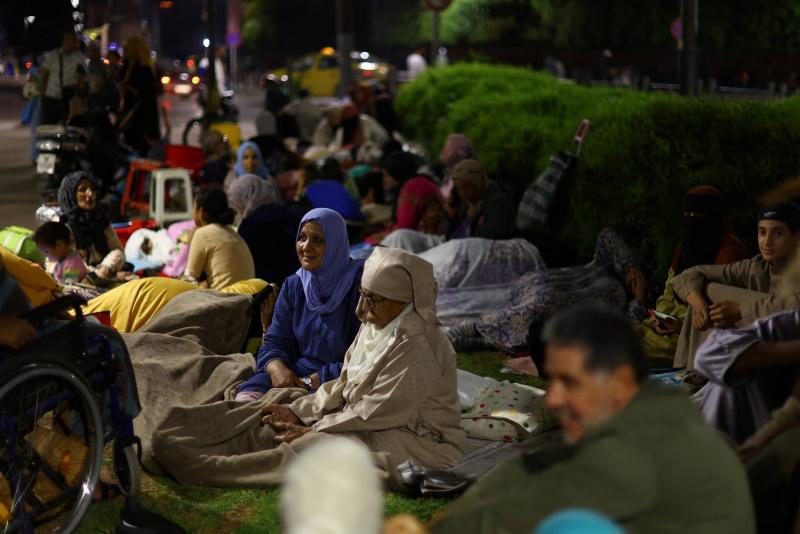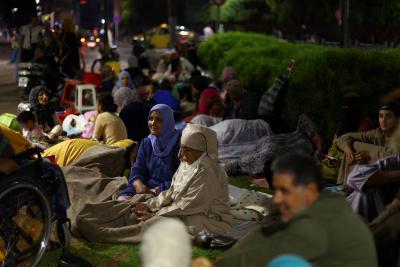The toll from the strongest earthquake to hit Morocco on Friday night has risen to more than two thousand dead, and the kingdom has declared three days of national mourning. The Interior Ministry announced, "As of 10 PM (21:00 GMT), the number of fatalities resulting from the earthquake has reached 2012." The number of injured has also increased to 2059, with 1404 in serious condition, according to the same source, which noted that authorities "continue their efforts to rescue the injured, evacuate, care for the wounded, and mobilize all necessary resources." Most of the fatalities are concentrated in the provinces of Al Haouz (1293) and Taroudant (452), which are the most affected areas south of Marrakech. These provinces contain many scattered villages in the heart of the Atlas Mountains, most of which are difficult to access, and most buildings do not comply with earthquake resistance standards.
The royal palace announced that King Mohammed VI chaired a meeting yesterday evening to discuss the situation following the disaster, during which a three-day national mourning was declared, and flags were ordered at half-mast. The king also called for a prayer in absentia in all mosques in the kingdom to honor the victims. He instructed the strengthening of search and rescue teams and the necessary means to expedite the rescue and evacuation of the injured. Moreover, the Moroccan monarch directed the formation of a ministerial committee to devise an urgent program for the rehabilitation and reconstruction of the affected areas, in addition to supplying these regions with potable water and distributing food rations, tents, and blankets to the victims. He emphasized the continued urgency of all rescue operations, with the participation of armed forces personnel.
Local channels aired aerial views of some villages that were completely destroyed, most of them made of adobe, in the mountainous Al Haouz region. Volunteer locals were seen participating in rescue operations. The kingdom awoke to the horror and panic following the shock of the earthquake, which measured 7 on the Richter scale, according to the National Center for Scientific and Technical Research, which indicated that its epicenter is located in the region of Al Haouz, southwest of Marrakech, a major tourist destination. Among the villages that seem to have been nearly entirely destroyed is Tifgaght, located about 50 kilometers from the earthquake's epicenter and approximately 60 kilometers southwest of Marrakech. Few buildings remain standing in this mountain village.
Members of the Royal Armed Forces continued searching to retrieve bodies from the rubble. Residents of the village gathered at a cemetery to bury around seventy victims amidst cries and wailing. This is the strongest earthquake to strike Morocco, but it has also been described as "extraordinary" due to its epicenter located in the heart of the High Atlas Mountains. The head of the rescue operations section at the General Directorate of Civil Protection, Hicham Chakri, told public television, "We are facing an emergency situation, but at the same time, it is extraordinary because no one among the residents expected an earthquake in this area (...) its strength and location make it an exceptional earthquake." For his part, the director of the National Institute of Geophysics, Nasser Jabour, predicted an increase in the death toll "given the strength of the earthquake and the extent of the geographic area affected."
Families in the Open
Families gathered in Marrakech in the early hours of Sunday morning, having spent a second night in the streets after the strongest earthquake to hit Morocco in over half a century, which led many to feel that their homes were no longer safe to return to. An atmosphere of uncertainty loomed over many in Marrakech, located about 70 kilometers northeast of the earthquake's epicenter, where they expressed concerns that the earthquake, which claimed the lives of over 2000 people, may have damaged their homes or potentially destroyed them in aftershocks in the coming hours or days.
Since Friday's earthquake, Mohammed Ayat Al-Hajj (51 years old) has been sleeping on the streets with his family near the historic city after discovering signs of damage to his home, evidenced by cracks in the walls. He told Reuters, "I can't sleep there. I am asking the authorities to help me and bring an expert to assess whether it's possible for me to return home or not. If there is danger, I will not go back home." Parts of the historic city of Marrakech, a popular tourist attraction for Moroccans and foreigners, were also damaged by the earthquake. Moroccans and foreigners walked the streets of the old city yesterday, taking pictures of the damage and dining in local restaurants, while others gathered to sleep in the main square.
Nour Eddine Lahbabi, a 68-year-old retired man with four children, was preparing to sleep outside for a second night and expressed sorrow and pain over the damage inflicted on people's homes. He said, "It’s a painful experience. When it happens to your brother or sister, it is really painful." Away from the city, families slept in open areas along the roads. Eleven-year-old Jora, speaking next to her father, expressed her discomfort about having to sleep near strangers.




